Archive
Josef Breitenbach
- Josef
- Breitenbach
Joseph Breitenbach
- 03-04-1896
- München (DE)
- 07-10-1984
- New York City (US)
- Photographer
On arriving in New York in 1941, the German photographer Josef Breitenbach tried to restart as a portrait, street and experimental photographer, as well as a teacher of photo-history and techniques.
Word Count: 30
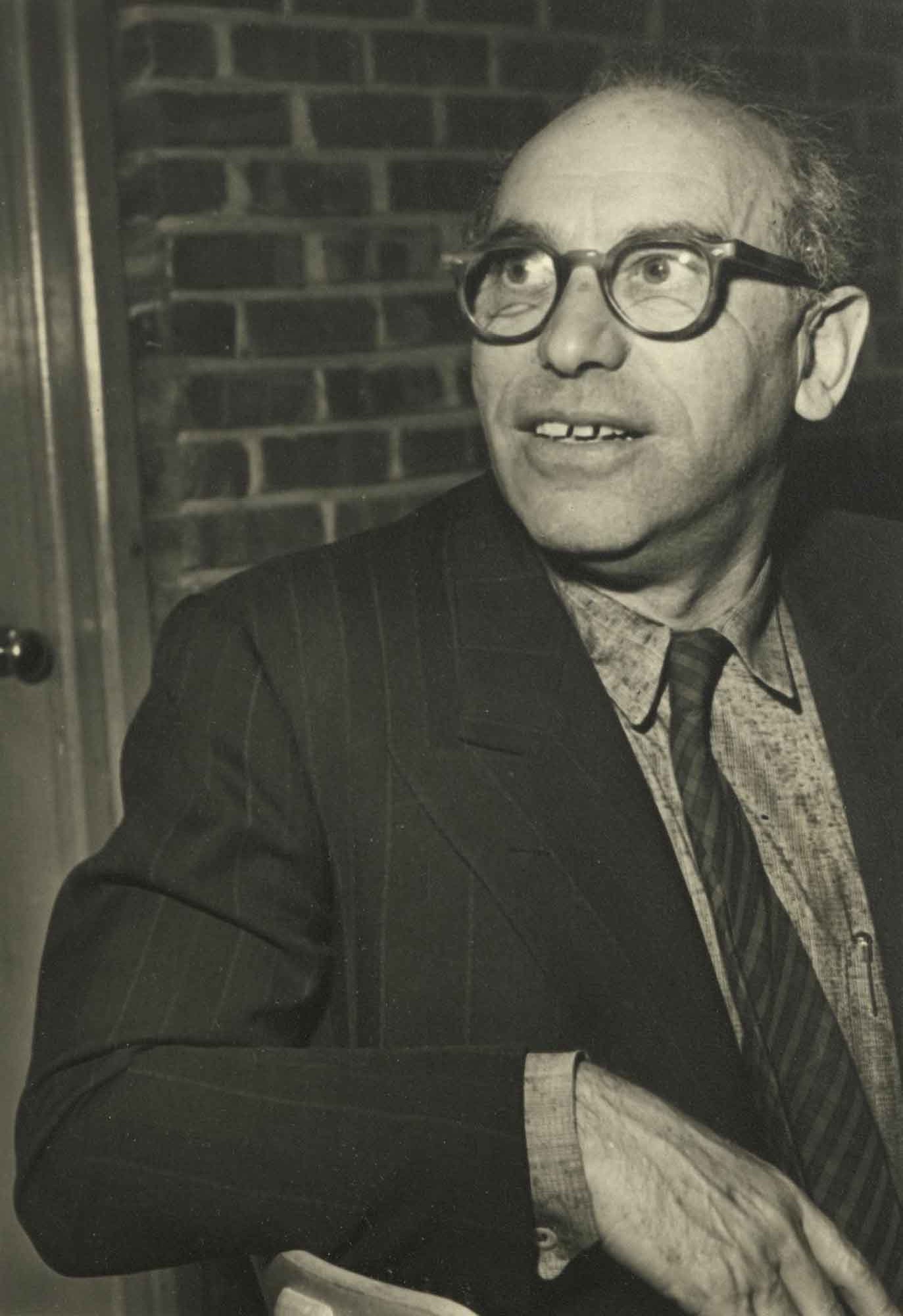
Fred Stein, Joseph Breitenbach, n.d. (© Deutsche Nationalbibliothek. Deutsches Exilarchiv 1933-1945, Frankfurt am Main). 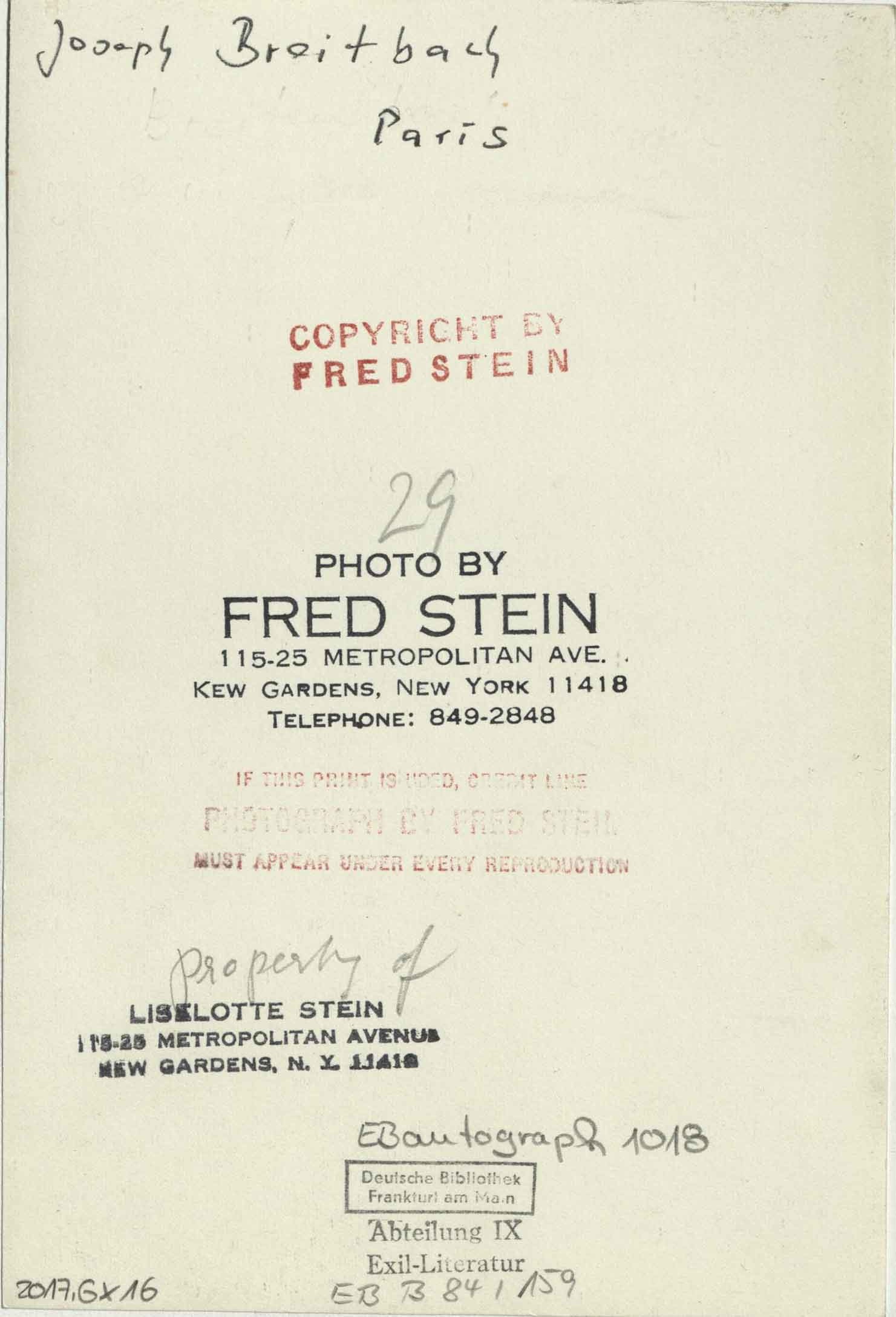
Fred Stein, Backside portrait Joseph Breitenbach, n.d. (© Deutsche Nationalbibliothek. Deutsches Exilarchiv 1933-1945, Frankfurt am Main). 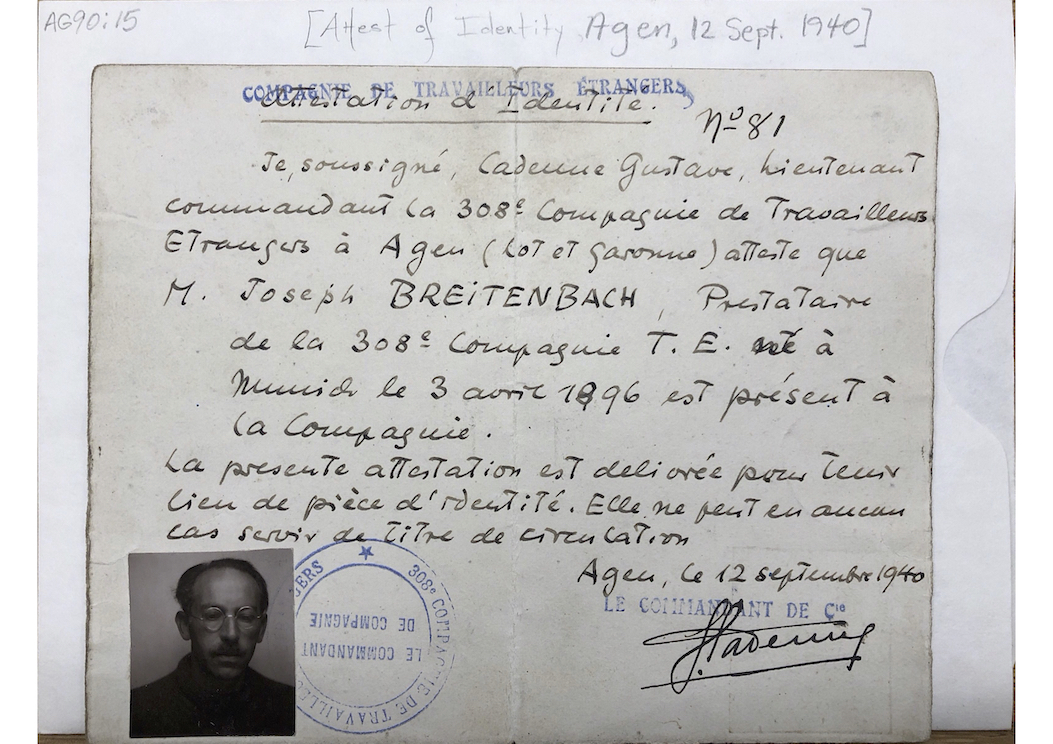
Attestation of Identity of Josef Breitenbach, Agen, September 1940 (© The Josef and Yaye Breitenbach Charitable Foundation, courtesy of The Center for Creative Photography, Josef Breitenbach Archive, AG90:5). 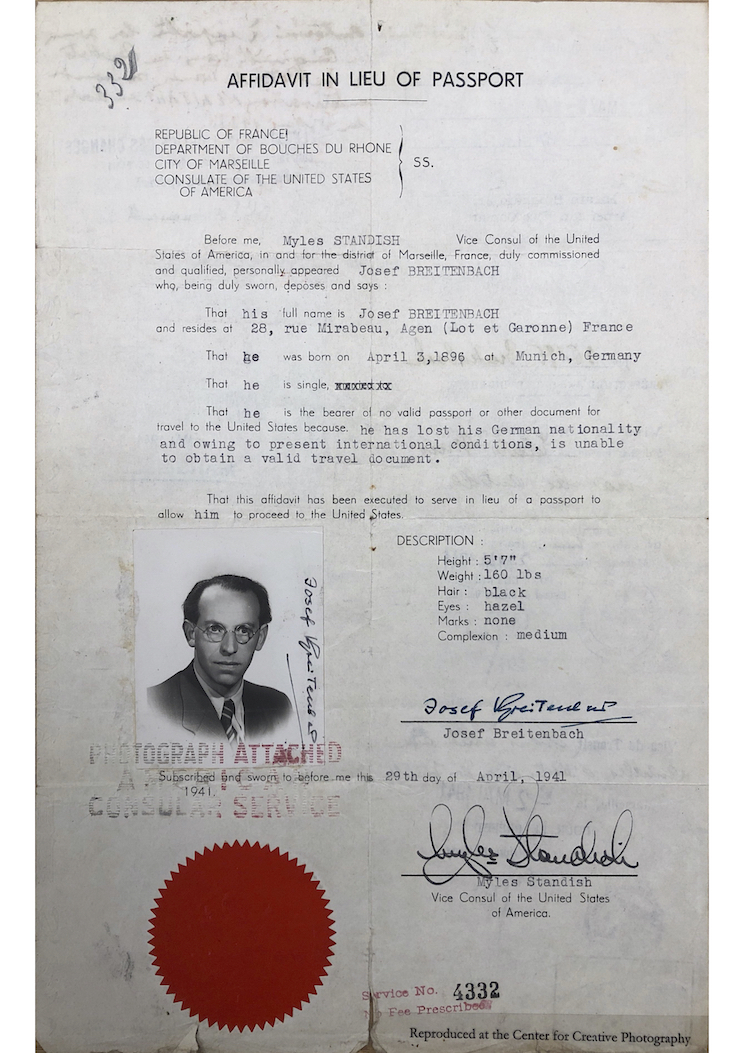
Affidavit for Josef Breitenbach, April 1941 (© The Josef and Yaye Breitenbach Charitable Foundation, courtesy of The Center for Creative Photography, Josef Breitenbach Archive, AG90:12). 
Address book Josef Breitenbach, New York (© The Josef and Yaye Breitenbach Charitable Foundation, courtesy of The Center for Creative Photography, Josef Breitenbach Archive, AG90:6). 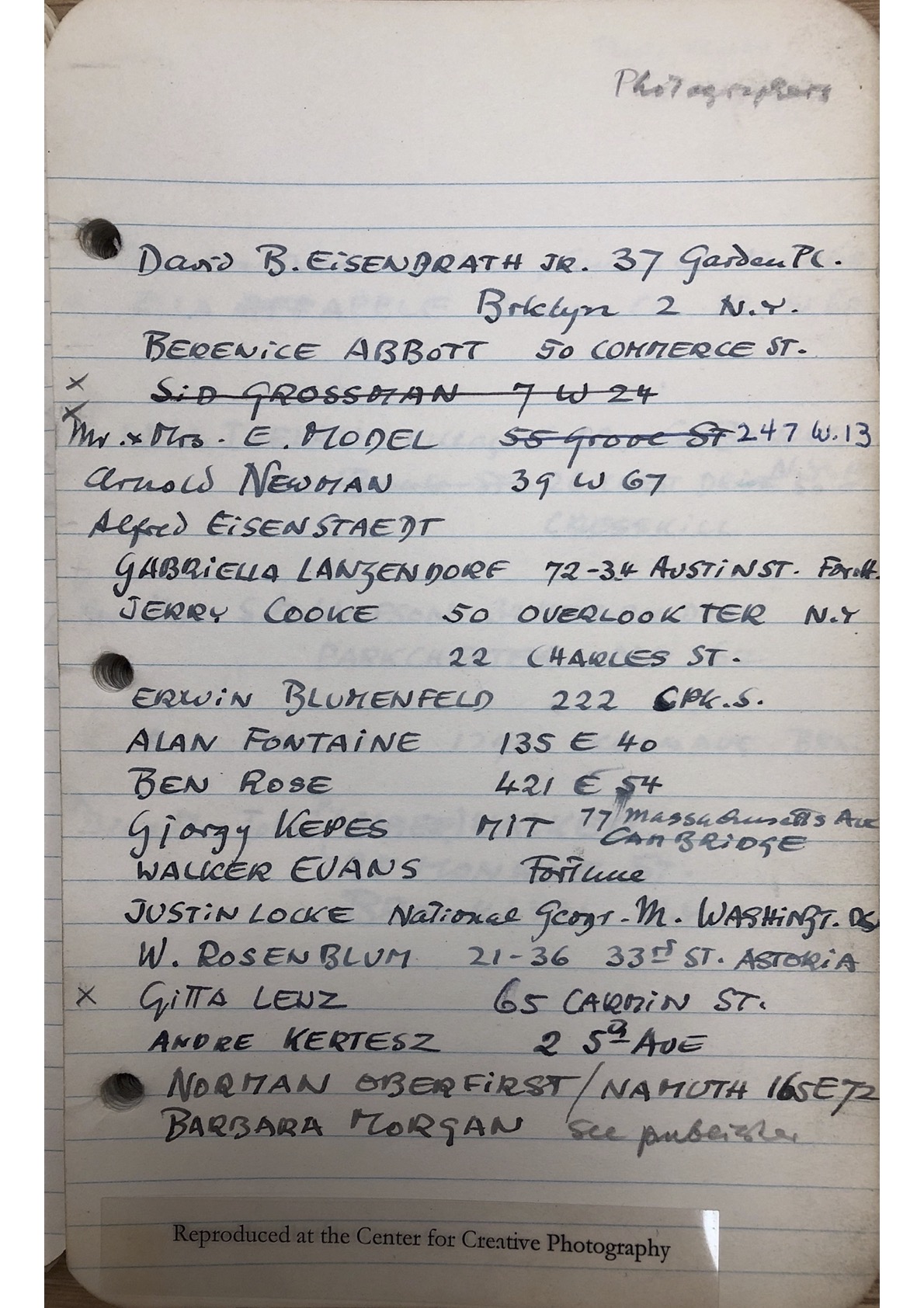
Page with collected addresses of photographers in New York by Josef Breitenbach (© The Josef and Yaye Breitenbach Charitable Foundation, courtesy of The Center for Creative Photography, Josef Breitenbach Archive, AG90:6). 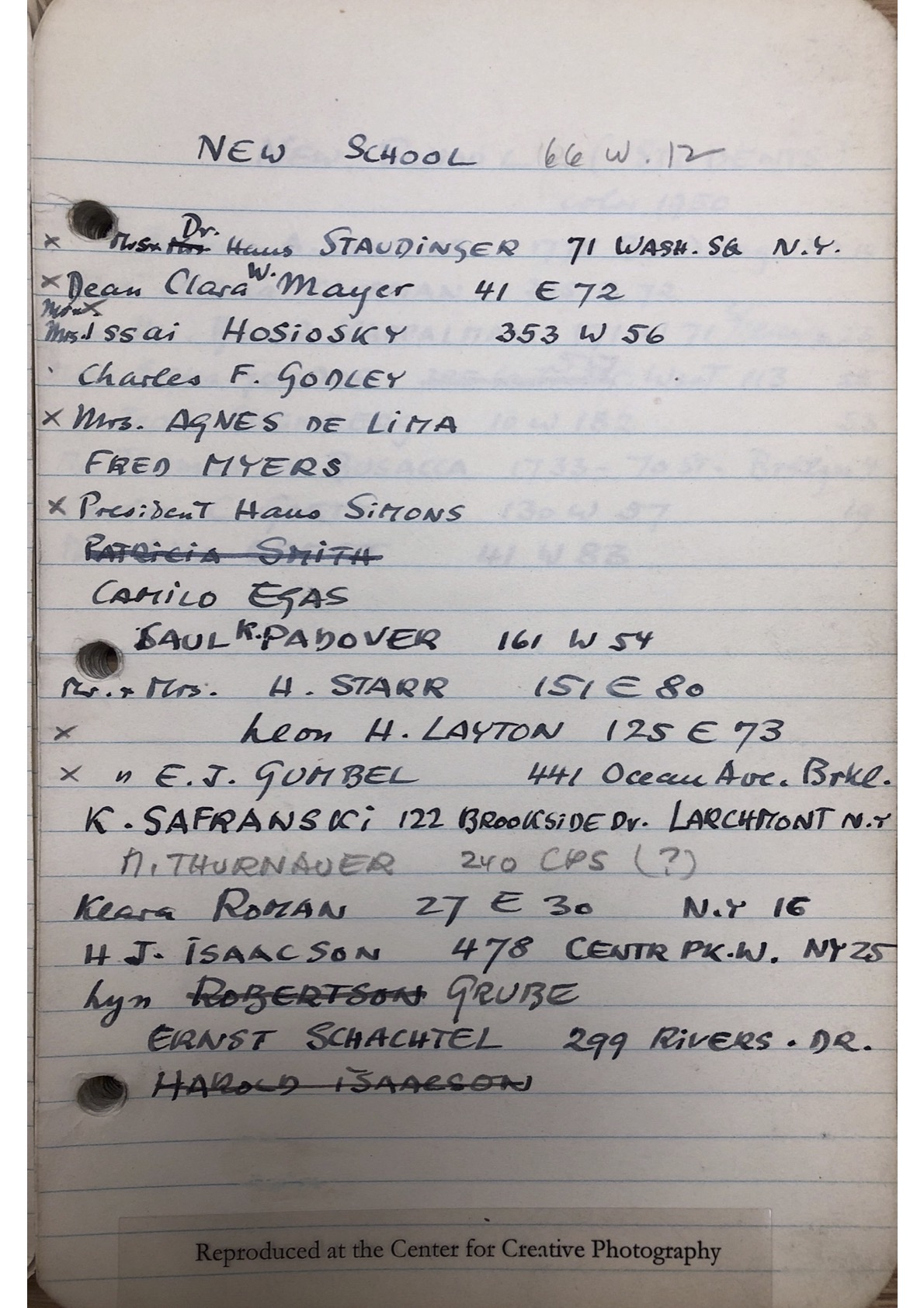
Page with collected addresses of colleagues at the New School for Social Research in New York by Josef Breitenbach (© The Josef and Yaye Breitenbach Charitable Foundation, courtesy of The Center for Creative Photography, Josef Breitenbach Archive, AG90:6). 
Application for use of photographic equipment by Josef Breitenbach, 1942 (© The Josef and Yaye Breitenbach Charitable Foundation, courtesy of The Center for Creative Photography, Josef Breitenbach Archive, AG90:12). 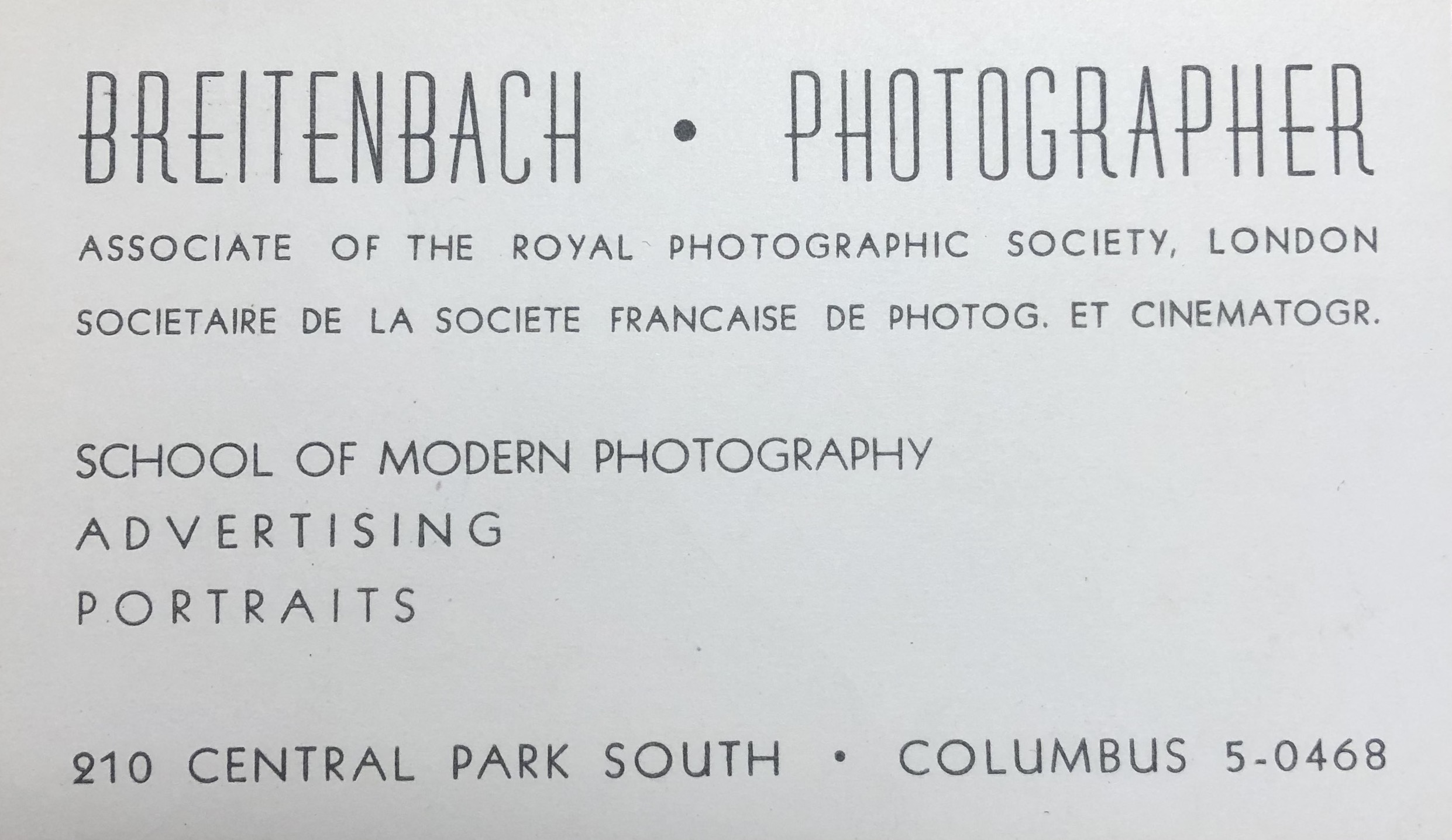
Business card Josef Breitenbach (© The Josef and Yaye Breitenbach Charitable Foundation, courtesy of The Center for Creative Photography, Josef Breitenbach Archive, AG90:6). 
Letter from Fortune Magazine, 1942 (© Josef Breitenbach Archive, AG90:4, Center for Creative Photography, The University of Arizona). Die Sammlung Josef Breitenbach. Zur Geschichte der Fotografie, exh. cat Fotomuseum im Münchner Stadtmuseum, Munich, 1979.
Displaced Visions. Émigré Photographers of the 20th Century, edited by Nissan N. Perez, exh. cat. The Israel Museum, Jerusalem, 2013.
Dogramaci, Burcu, and Helene Roth, editors. Nomadic Camera. Fotografie, Exil und Migration, special issue of Fotogeschichte. Beiträge zur Geschichte und Ästhetik der Fotografie, vol. 39, no. 151, 2019.
Gilbert, George. The Illustrated Worldwide Who’s Who of Jews in Photography. G. Gilbert, 1996.
Josef Breitenbach, edited by Larisa Dryansky, exh. cat. Musée Nicéphore Niépce, Chalon-sur-Saône, 2001.
Josef Breitenbach. Photographien. Zum 100. Geburtstag, edited by T.O. Immisch et al., exh. cat. Staatliche Galerie Mortizburg, Halle (Saale) / Fotomuseum im Münchner Stadtmuseum, Munich, 1996.
Modern Look. Photography and the American Magazine, edited by Mason Klein, exh. cat. Jewish Museum, New York, 2020.
Neugass, Fritz. “The saga of the S.S. Winnipeg.” Modern Photography, July 1951, pp. 72–75; 86; 88.
New York Photography 1890–1950. Von Stieglitz bis Man Ray, edited by Ortrud Westheider and Michael Philipp, exh. cat. Bucerius Kunst Forum, Hamburg, 2012.
Roth, Helene. “First Pictures: New York through the lens of emigrated European photographers in the 1930s and 1940s.” Contact Zones: Photography, Migration and Cultural Encounters in the United States, edited by Justin Carville and Sigrid Lien, Leuven University Press, 2021, pp. 111–132.
Schaber, Irme. “Fotografie.” Handbuch der deutschsprachigen Emigration 1933–1945, edited by Claus-Dieter Krohn and Patrick von zur Mühlen, WBG, 1998, pp. 970–983.
Schaber, Irme. “‘Die Kamera ist ein Instrument der Entdeckung…’. Die Großstadtfotografie der fotografischen Emigration in der NS-Zeit in Paris, London und New York.” Exilforschung. Ein internationales Jahrbuch, vol. 20: Metropolen des Exils, edited by Claus-Dieter Krohn, edition text + kritik, 2002, pp. 53–73.
Schopf, Wolfgang. “Blende auf: Josef Breitenbach.” Fractured Biographies, edited by Ian Wallace, Rodopi, 2003, pp. 17–53.
Unbelichtet. Münchner Fotografen im Exil, edited by Tatjana Neef, exh. cat. Jüdisches Museum München, Munich, 2010.
Und sie haben Deutschland verlassen … müssen. Fotografen und ihre Bilder 1928–1997, edited by Klaus Honnef and Frank Weyers, exh. cat. Rheinisches Landesmuseum Bonn, Bonn, 1997.
Word Count: 381
Photographic Collection of Joseph Breitenbach, Stadtmuseum München – Sammlung Fotografie, Munich.
The Cleveland Museum of Art, Cleveland.
The J. Paul Getty Museum, Los Angeles.
The Metropolitan Museum of Art, New York.
Word Count: 59
Paris, France (1933-1939); Internment Camp, Colombess, Begny sur Craôn, Agen France (1939/41); Marseille, France (1941); New York City, US (1941-1984).
70 Morningside Drive, Morningside Heights, New York City (residence and studio, 1941), 210 Central Park South, Central Park South, New York City (residence and studio, 1941-1962), 165 West 66th Street, Lincoln Square, New York City (residence and studio, 1962-1968).
- New York
- Helene Roth. "Josef Breitenbach." METROMOD Archive, 2021, https://archive.metromod.net/viewer.p/69/2948/object/5138-8099797, last modified: 21-09-2021.
-
Hermann LandshoffPhotographerNew York
Besides outdoor fashion shots, Hermann Landshoff was a portrait and street photographer. During his time in New York, he captured the cultural, artistic and intellectual émigré scene as well as his photographer colleagues.
Word Count: 33
Walter SandersPhotographerNew YorkWalter Sanders was a German émigré photographer. In 1938 he arrived in New York, where he worked from 1939 until the end of his life for the Black Star agency and, from 1944, for Life magazine.
Word Count: 33
Kurt SafranskiPicture AgentFounding MemberTeacherCartoonistPublisherIllustratorNew YorkKurt Safranski was one of the founding members of the Black Star photo agency, a teacher at the New School for Social Research and the author of photojournalistic articles and books.
Word Count: 31
Andreas FeiningerPhotographerWriterEditorNew YorkAndreas Feininger, was a German émigré photographer who arrived in New York with his wife Wysse Feininger in 1939. He started a lifelong career exploring the city's streets, working as a photojournalist and writing a large number of photography manuals.
Word Count: 39
Ruth BernhardPhotographerNew YorkRuth Bernhard was a German émigré photographer who lived in New York from the 1920s to the 1940s. Beside her series on female nudes, her place in the photography network, as well as in the New York queer scene, is unknown and understudied.
Word Count: 43
Lisette ModelPhotographerNew YorkLisette Model was an Austrian-born photographer who lived in New York with her husband Evsa Model after emigrating from France. Her street photographs capturing the curiosities of everyday life quickly caught the interest of museums and magazines.
Word Count: 37
Fred SteinPhotographerLawyerNew YorkAlways accompanied by his camera, the German émigré photographer Fred Stein discovered New York City during the 1940s and 1950s. His pictures provide an human and multifaceted view of the metropolis.
Word Count: 31
Alexey BrodovitchPhotographerArt DirectorGraphic DesignerNew YorkAlexey Brodovitch was a Belarus-born émigré graphic artist, art director and photographer who, from 1933, worked in New York for Harper’s Bazaar magazine and at the New School for Social Research.
Word Count: 31
Charles LeirensPhotographerMusicianMusicologistNew YorkCharles Leirens was a Belgian-born musician and photographer who emigrated to New York in 1941. While publishing two books on Belgian music, he also gave courses in musicology and photography at the New School for Social Research.
Word Count: 36
Rolf TietgensPhotographerEditorWriterNew YorkRolf Tietgens was a German émigré photographer who arrived in New York in 1938. Although, in the course of his photographic career, his artistic and surrealist images were published and shown at exhibitions, his work, today, is very little known.
Word Count: 39
Marion PalfiPhotographerNew YorkMarion Palfi was a German émigré photographer who lived in New York from the 1940s to the 1960s. Her photographic engagement in social and political topics made her name for her use of the camera to draw attention to social injustices.
Word Count: 41
Lotte JacobiPhotographerNew YorkIn October 1935 the German émigré photographer Lotte Jacobi, together with her sister Ruth Jacobi, opened a photo studio on 57th Street. The two sisters had to leave their parents' photo studio in Berlin in the 1930s and emigrated to New York.
Word Count: 41
Tim GidalPhotographerPublisherArt HistorianNew YorkTim Gidal was a German-Jewish photographer, publisher and art historian emigrating in 1948 emigrated to New York. Besides his teaching career, he worked as a photojournalist and, along with his wife Sonia Gidal, published youth books.
Word Count: 35
Lilo HessPhotographerNew YorkThe German émigré Lilo Hess was an animal photographer working for the Museum for Natural History and the Bronx Zoo, as well being a freelance photographer and publisher of children's books.
Word Count: 31
Ruth JacobiPhotographerNew YorkRuth Jacobi was a German-speaking, Polish-born photographer who emigrated in 1935 to New York, where she opened a studio together with her sister Lotte Jacobi. She later had her own portrait studio.
Word Count: 31
YllaPhotographerNew YorkYlla was an Austrian-born photographer who emigrated to New York in 1941. Specialising in animal photography, she produced not only studio photographs, but also shot outside on urban locations in the metropolis.
Word Count: 31
Fritz HenlePhotographerNew YorkFritz Henle was a German Jewish photographer who emigrated in 1936 to New York, where he worked as a photojournalist for various magazines. He also published several photobooks of his travels throughout North America and Asia.
Word Count: 35
Ruth StaudingerPhotographerCinematographerArt dealerNew YorkVery few and only fragmentary details can be found on the German émigré photographer Ruth Staudinger, who emigrated in the mid-1930s to New York City. Her nomadic life was also characterisedd by several changes of name along the way.
Word Count: 40
Carola GregorPhotographerSculptorNew YorkThe German émigré photographer Carola Gregor was an animal and child photographer and published some of her work in magazines and books. Today her work and life are almost forgotten.
Word Count: 30
Trude FleischmannPhotographerNew YorkTrude Fleischmann was an Austrian-Jewish portrait and dance photographer who emigrated in 1939 to New York, where she opened a studio in Midtown Manhattan with the photographer Frank Elmer.
Word Count: 28
PIX Publishing Inc.Photo AgencyNew YorkPIX Publishing Inc. was a photo agency founded in New York in 1935 by photo agent Leon Daniel and Celia Kutschuk, together with German émigré photographers Alfred Eisenstaedt and George Karger.
Word Count: 30
New School for Social ResearchAcademy/Art SchoolPhoto SchoolUniversity / Higher Education Institute / Research InstituteNew YorkDuring the 1940s and 1950s emigrated graphic designers and photographers, along with artists and intellectuals, were given the opportunity to held lectures and workshops at the New School for Social Research.
Word Count: 31
Norlyst GalleryGalleryArt GalleryNew YorkFounded in 1943 by the American painter and art collector Elenore Lust, the Norlyst Gallery represented a cross section of contemporary painting, photography and other media focusing on surrealist and abstract expressionist styles and promoting women artists and photographers.
Word Count: 38
SpiratonePhoto SupplierNew YorkSpiratone was a photo company and photo supplier founded in 1941 by the Austrian émigré family Hans (1888–1944) and Paula Spira (?–?) and their son Fred Spira (1924–2007).
Word Count: 24
László Moholy-NagyPhotographerGraphic DesignerPainterSculptorLondonLászló Moholy-Nagy emigrated to London in 1935, where he worked in close contact with the local avantgarde and was commissioned for window display decoration, photo books, advertising and film work.
Word Count: 30
Lighting for Photography. Means and MethodsPhoto guideBookLondonLighting for Photography from 1940 by the émigré photographer Walter Nurnberg was one of a number of successful photo guides produced by Andor Kraszna-Krausz’s Focal Press publishing house.
Word Count: 28